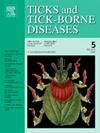Anaplasma capra and Haemaphysalis concinna: Investigating a potential vector relationship in a wildlife reserve
IF 3.4
2区 医学
Q2 INFECTIOUS DISEASES
引用次数: 0
Abstract
Recently, Anaplasma capra, a new member of the Anaplasmataceae, has been described in Asia and Europe. This pathogen infects a range of hosts, including small ruminants, cervids, and humans, and has been detected across several tick genera. In this study, we aimed to identify potential transmission vectors of A. capra by screening questing ticks from a wild fauna reserve where it had previously been detected in its red deer (Cervus elaphus) and swamp deer (Rucervus duvaucelii) populations. DNA of Anaplasma capra was sought in the dissected salivary glands of 198 adult questing Haemaphysalis concinna and 74 adult questing Haemaphysalis inermis ticks, which were collected from vegetation by visual inspection. Anaplasma capra was detected in the salivary glands of a single female H. concinna, suggesting potential vector competence for this pathogen. Sequences of the gltA and 16S rRNA genes from this sample were identical to those previously obtained from deer blood samples within the reserve. We also confirmed the circulation of A. capra in additional red deer within the reserve.
卡无原体与中国血蜱:野生动物保护区潜在媒介关系的调查
近年来,在亚洲和欧洲发现了无原体科的新成员无原体capra。这种病原体感染一系列宿主,包括小型反刍动物、动物和人类,并在几种蜱属中被发现。在本研究中,我们的目的是通过筛选来自野生动物保护区的蜱虫,以确定capra的潜在传播媒介,该保护区以前在马鹿(Cervus elaphus)和沼泽鹿(Rucervus duvaucelii)种群中检测到该蜱虫。对从植被中采集的198只腹血蜱成虫和74只不染血蜱成虫的唾液腺进行了解剖,寻找了卡无原体DNA。在一只雌性红腹圆蝽的唾液腺中检测到无原体,提示该病原体具有潜在的媒介能力。该样本的gltA和16S rRNA基因序列与先前从保护区内的鹿血液样本中获得的序列相同。我们还证实了在保护区内的其他马鹿中也有卡普拉菌的传播。
本文章由计算机程序翻译,如有差异,请以英文原文为准。
求助全文
约1分钟内获得全文
求助全文
来源期刊

Ticks and Tick-borne Diseases
INFECTIOUS DISEASES-MICROBIOLOGY
CiteScore
6.90
自引率
12.50%
发文量
185
审稿时长
6-12 weeks
期刊介绍:
Ticks and Tick-borne Diseases is an international, peer-reviewed scientific journal. It publishes original research papers, short communications, state-of-the-art mini-reviews, letters to the editor, clinical-case studies, announcements of pertinent international meetings, and editorials.
The journal covers a broad spectrum and brings together various disciplines, for example, zoology, microbiology, molecular biology, genetics, mathematical modelling, veterinary and human medicine. Multidisciplinary approaches and the use of conventional and novel methods/methodologies (in the field and in the laboratory) are crucial for deeper understanding of the natural processes and human behaviour/activities that result in human or animal diseases and in economic effects of ticks and tick-borne pathogens. Such understanding is essential for management of tick populations and tick-borne diseases in an effective and environmentally acceptable manner.
 求助内容:
求助内容: 应助结果提醒方式:
应助结果提醒方式:


